Abstract
Possible pathways for translocation across the membrane in active transport processes are examined theoretically. Thermodynamic and kinetic requirements are readily satisfied by an alternating-access mechanism of the kind that has been proposed in the past by several investigators. The essential features of this mechanism (for transport of a single species) are shown to be defined by four explicit conditions. (i) The transport protein must have at least two distinct conformational states, each accessible from only one side of the membrane. (ii) Binding affinity for the transported species is high in the state accessible from the uptake side of the membrane and much lower in the state accessible from the discharge side. (iii) The change from one conformation to the other involves movement of the binding site itself (with the transported species remaining attached) or rearrangement within the site that is topologically equivalent to such movement. (iv) Return to the original conformation occurs with unoccupied binding sites. The analysis demonstrates that a passage through the membrane that is simultaneously accessible from both sides cannot be used for active transport regardless of what the energetics of opening or closing of the passage may be. Even movement from one fixed site to another within the protein, without access to the outside, is virtually excluded as a possible element of the central mechanism. A ligand conduction mechanism for ATP-linked ion transport is in principle conceivable but is subject to restrictions that make it improbable.
Full text
PDF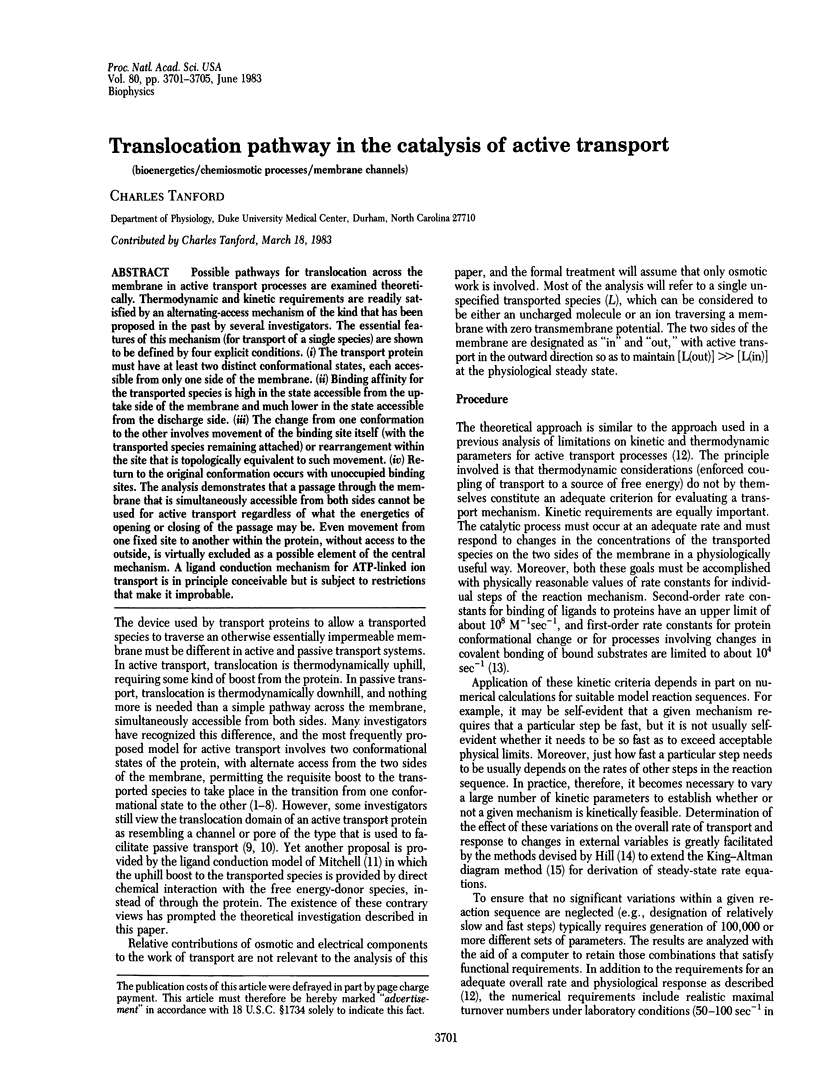
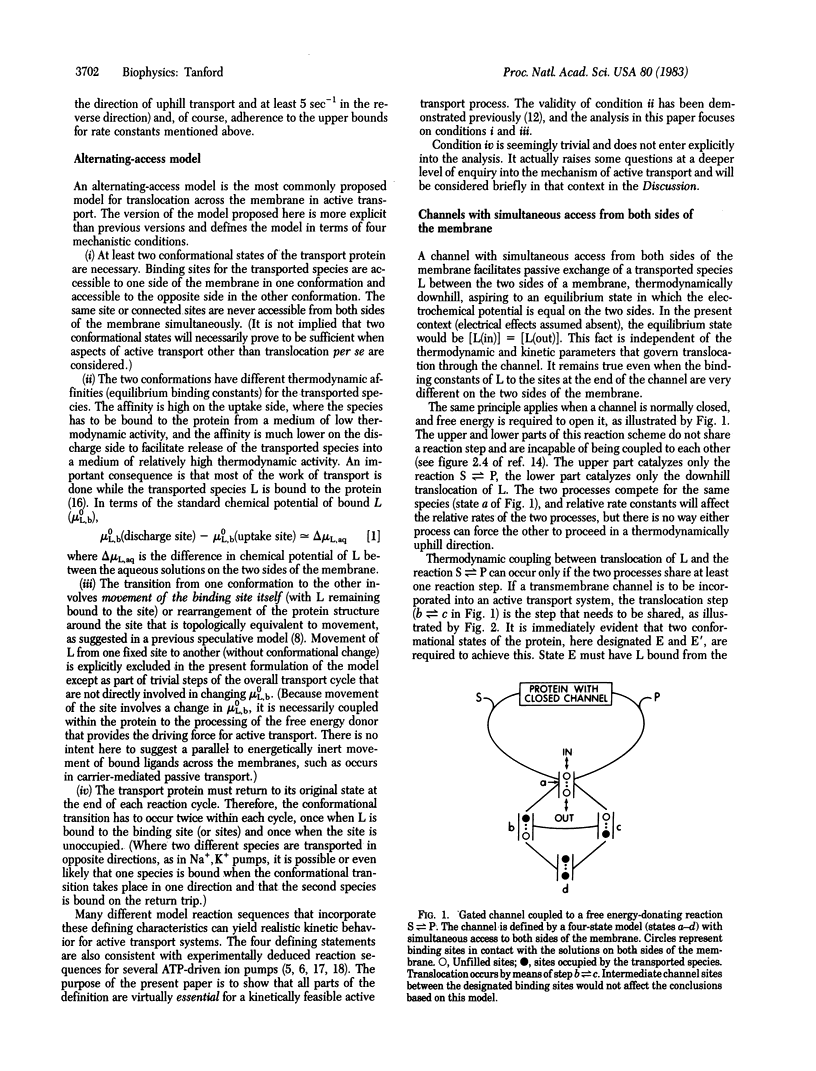
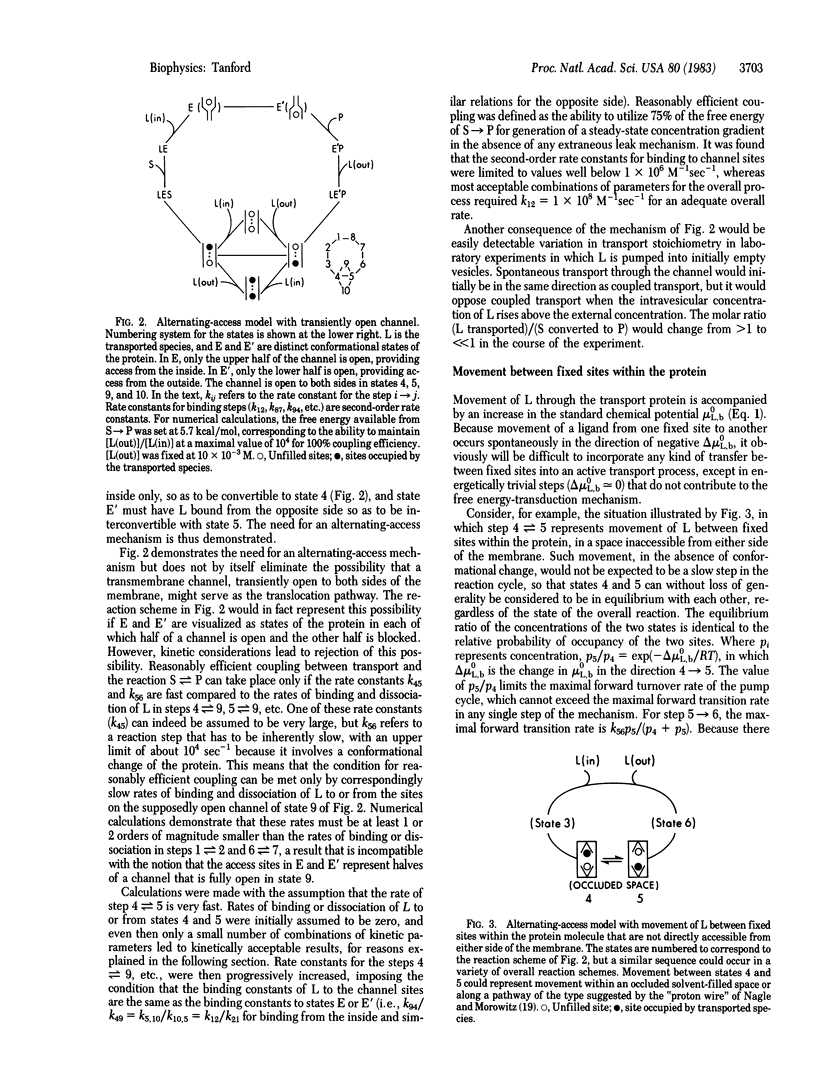
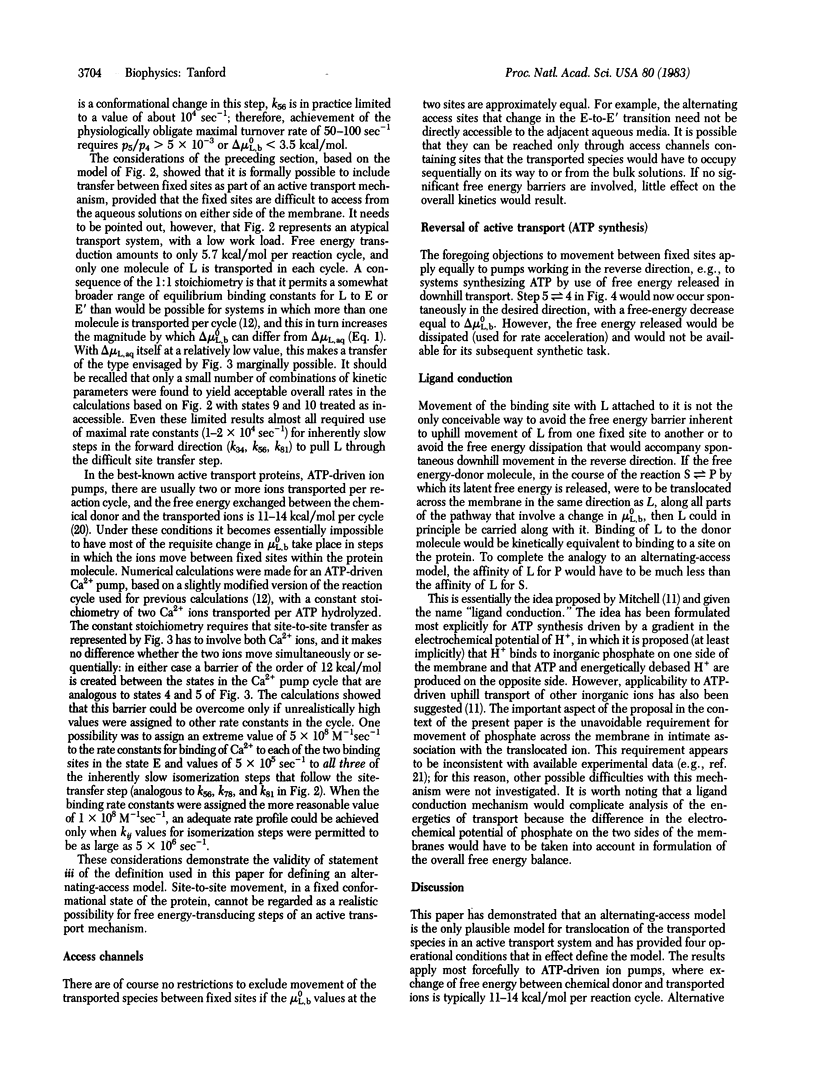
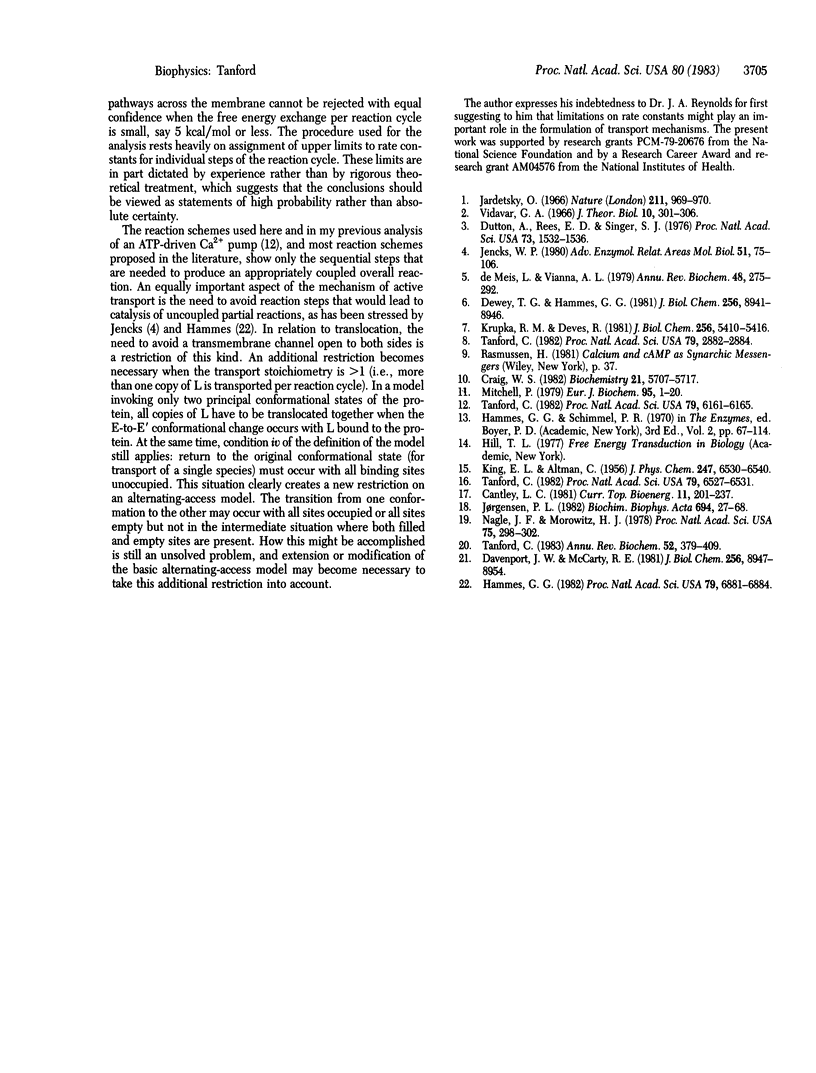
Selected References
These references are in PubMed. This may not be the complete list of references from this article.
- Craig W. S. Monomer of sodium and potassium ion activated adenosinetriphosphatase displays complete enzymatic function. Biochemistry. 1982 Oct 26;21(22):5707–5717. doi: 10.1021/bi00265a049. [DOI] [PubMed] [Google Scholar]
- Davenport J. W., McCarty R. E. Quantitative aspects of adenosine triphosphate-driven proton translocation in spinach chloroplast thylakoids. J Biol Chem. 1981 Sep 10;256(17):8947–8954. [PubMed] [Google Scholar]
- Dewey T. G., Hammes G. G. Steady state kinetics of ATP synthesis and hydrolysis catalyzed by reconstituted chloroplast coupling factor. J Biol Chem. 1981 Sep 10;256(17):8941–8946. [PubMed] [Google Scholar]
- Dutton A., Rees E. D., Singer S. J. An experiment eliminating the rotating carrier mechanism for the active transport of Ca ion in sarcoplasmic reticulum membranes. Proc Natl Acad Sci U S A. 1976 May;73(5):1532–1536. doi: 10.1073/pnas.73.5.1532. [DOI] [PMC free article] [PubMed] [Google Scholar]
- Hammes G. G. Unifying concept for the coupling between ion pumping and ATP hydrolysis or synthesis. Proc Natl Acad Sci U S A. 1982 Nov;79(22):6881–6884. doi: 10.1073/pnas.79.22.6881. [DOI] [PMC free article] [PubMed] [Google Scholar]
- Jardetzky O. Simple allosteric model for membrane pumps. Nature. 1966 Aug 27;211(5052):969–970. doi: 10.1038/211969a0. [DOI] [PubMed] [Google Scholar]
- Jencks W. P. The utilization of binding energy in coupled vectorial processes. Adv Enzymol Relat Areas Mol Biol. 1980;51:75–106. doi: 10.1002/9780470122969.ch2. [DOI] [PubMed] [Google Scholar]
- Jørgensen P. L. Mechanism of the Na+, K+ pump. Protein structure and conformations of the pure (Na+ +K+)-ATPase. Biochim Biophys Acta. 1982 Aug 11;694(1):27–68. doi: 10.1016/0304-4157(82)90013-2. [DOI] [PubMed] [Google Scholar]
- Krupka R. M., Devés R. An experimental test for cyclic versus linear transport models. The mechanisms of glucose and choline transport in erythrocytes. J Biol Chem. 1981 Jun 10;256(11):5410–5416. [PubMed] [Google Scholar]
- Mitchell P. The Ninth Sir Hans Krebs Lecture. Compartmentation and communication in living systems. Ligand conduction: a general catalytic principle in chemical, osmotic and chemiosmotic reaction systems. Eur J Biochem. 1979 Mar 15;95(1):1–20. doi: 10.1111/j.1432-1033.1979.tb12934.x. [DOI] [PubMed] [Google Scholar]
- Nagle J. F., Morowitz H. J. Molecular mechanisms for proton transport in membranes. Proc Natl Acad Sci U S A. 1978 Jan;75(1):298–302. doi: 10.1073/pnas.75.1.298. [DOI] [PMC free article] [PubMed] [Google Scholar]
- Tanford C. Mechanism of active transport: free energy dissipation and free energy transduction. Proc Natl Acad Sci U S A. 1982 Nov;79(21):6527–6531. doi: 10.1073/pnas.79.21.6527. [DOI] [PMC free article] [PubMed] [Google Scholar]
- Tanford C. Mechanism of free energy coupling in active transport. Annu Rev Biochem. 1983;52:379–409. doi: 10.1146/annurev.bi.52.070183.002115. [DOI] [PubMed] [Google Scholar]
- Tanford C. Simple model for the chemical potential change of a transported ion in active transport. Proc Natl Acad Sci U S A. 1982 May;79(9):2882–2884. doi: 10.1073/pnas.79.9.2882. [DOI] [PMC free article] [PubMed] [Google Scholar]
- Tanford C. Steady state of an ATP-driven calcium pump: limitations on kinetic and thermodynamic parameters. Proc Natl Acad Sci U S A. 1982 Oct;79(20):6161–6165. doi: 10.1073/pnas.79.20.6161. [DOI] [PMC free article] [PubMed] [Google Scholar]
- Vidaver G. A. Inhibition of parallel flux and augmentation of counter flux shown by transport models not involving a mobile carrier. J Theor Biol. 1966 Feb;10(2):301–306. doi: 10.1016/0022-5193(66)90128-7. [DOI] [PubMed] [Google Scholar]
- de Meis L., Vianna A. L. Energy interconversion by the Ca2+-dependent ATPase of the sarcoplasmic reticulum. Annu Rev Biochem. 1979;48:275–292. doi: 10.1146/annurev.bi.48.070179.001423. [DOI] [PubMed] [Google Scholar]


